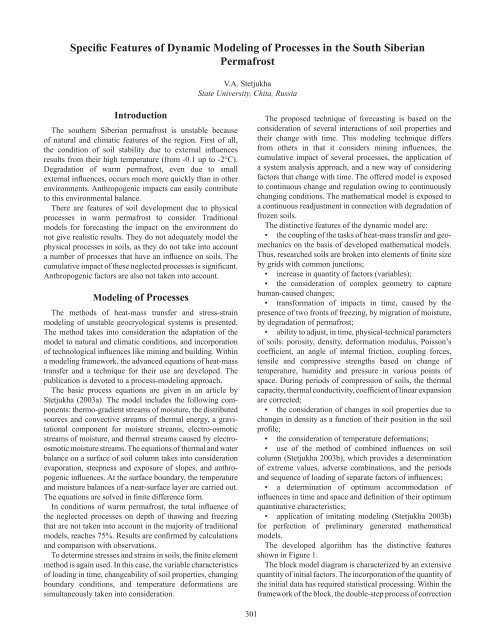Ninth International Conference on Permafrost ... - IARC Research
Ninth International Conference on Permafrost ... - IARC Research
Ninth International Conference on Permafrost ... - IARC Research
You also want an ePaper? Increase the reach of your titles
YUMPU automatically turns print PDFs into web optimized ePapers that Google loves.
Specific Features of Dynamic Modeling of Processes in the South Siberian<strong>Permafrost</strong>V.A. StetjukhaState University, Chita, RussiaIntroducti<strong>on</strong>The southern Siberian permafrost is unstable becauseof natural and climatic features of the regi<strong>on</strong>. First of all,the c<strong>on</strong>diti<strong>on</strong> of soil stability due to external influencesresults from their high temperature (from -0.1 up to -2°С).Degradati<strong>on</strong> of warm permafrost, even due to smallexternal influences, occurs much more quickly than in otherenvir<strong>on</strong>ments. Anthropogenic impacts can easily c<strong>on</strong>tributeto this envir<strong>on</strong>mental balance.There are features of soil development due to physicalprocesses in warm permafrost to c<strong>on</strong>sider. Traditi<strong>on</strong>almodels for forecasting the impact <strong>on</strong> the envir<strong>on</strong>ment d<strong>on</strong>ot give realistic results. They do not adequately model thephysical processes in soils, as they do not take into accounta number of processes that have an influence <strong>on</strong> soils. Thecumulative impact of these neglected processes is significant.Anthropogenic factors are also not taken into account.Modeling of ProcessesThe methods of heat-mass transfer and stress-strainmodeling of unstable geocryological systems is presented.The method takes into c<strong>on</strong>siderati<strong>on</strong> the adaptati<strong>on</strong> of themodel to natural and climatic c<strong>on</strong>diti<strong>on</strong>s, and incorporati<strong>on</strong>of technological influences like mining and building. Withina modeling framework, the advanced equati<strong>on</strong>s of heat-masstransfer and a technique for their use are developed. Thepublicati<strong>on</strong> is devoted to a process-modeling approach.The basic process equati<strong>on</strong>s are given in an article byStetjukha (2003a). The model includes the following comp<strong>on</strong>ents:thermo-gradient streams of moisture, the distributedsources and c<strong>on</strong>vective streams of thermal energy, a gravitati<strong>on</strong>alcomp<strong>on</strong>ent for moisture streams, electro-osmoticstreams of moisture, and thermal streams caused by electroosmoticmoisture streams. The equati<strong>on</strong>s of thermal and waterbalance <strong>on</strong> a surface of soil column takes into c<strong>on</strong>siderati<strong>on</strong>evaporati<strong>on</strong>, steepness and exposure of slopes, and anthropogenicinfluences. At the surface boundary, the temperatureand moisture balances of a near-surface layer are carried out.The equati<strong>on</strong>s are solved in finite difference form.In c<strong>on</strong>diti<strong>on</strong>s of warm permafrost, the total influence ofthe neglected processes <strong>on</strong> depth of thawing and freezingthat are not taken into account in the majority of traditi<strong>on</strong>almodels, reaches 75%. Results are c<strong>on</strong>firmed by calculati<strong>on</strong>sand comparis<strong>on</strong> with observati<strong>on</strong>s.To determine stresses and strains in soils, the finite elementmethod is again used. In this case, the variable characteristicsof loading in time, changeability of soil properties, changingboundary c<strong>on</strong>diti<strong>on</strong>s, and temperature deformati<strong>on</strong>s aresimultaneously taken into c<strong>on</strong>siderati<strong>on</strong>.The proposed technique of forecasting is based <strong>on</strong> thec<strong>on</strong>siderati<strong>on</strong> of several interacti<strong>on</strong>s of soil properties andtheir change with time. This modeling technique differsfrom others in that it c<strong>on</strong>siders mining influences, thecumulative impact of several processes, the applicati<strong>on</strong> ofa system analysis approach, and a new way of c<strong>on</strong>sideringfactors that change with time. The offered model is exposedto c<strong>on</strong>tinuous change and regulati<strong>on</strong> owing to c<strong>on</strong>tinuouslychanging c<strong>on</strong>diti<strong>on</strong>s. The mathematical model is exposed toa c<strong>on</strong>tinuous readjustment in c<strong>on</strong>necti<strong>on</strong> with degradati<strong>on</strong> offrozen soils.The distinctive features of the dynamic model are:• the coupling of the tasks of heat-mass transfer and geomechanics<strong>on</strong> the basis of developed mathematical models.Thus, researched soils are broken into elements of finite sizeby grids with comm<strong>on</strong> juncti<strong>on</strong>s;• increase in quantity of factors (variables);• the c<strong>on</strong>siderati<strong>on</strong> of complex geometry to capturehuman-caused changes;• transformati<strong>on</strong> of impacts in time, caused by thepresence of two fr<strong>on</strong>ts of freezing, by migrati<strong>on</strong> of moisture,by degradati<strong>on</strong> of permafrost;• ability to adjust, in time, physical-technical parametersof soils: porosity, density, deformati<strong>on</strong> modulus, Poiss<strong>on</strong>’scoefficient, an angle of internal fricti<strong>on</strong>, coupling forces,tensile and compressive strengths based <strong>on</strong> change oftemperature, humidity and pressure in various points ofspace. During periods of compressi<strong>on</strong> of soils, the thermalcapacity, thermal c<strong>on</strong>ductivity, coefficient of linear expansi<strong>on</strong>are corrected;• the c<strong>on</strong>siderati<strong>on</strong> of changes in soil properties due tochanges in density as a functi<strong>on</strong> of their positi<strong>on</strong> in the soilprofile;• the c<strong>on</strong>siderati<strong>on</strong> of temperature deformati<strong>on</strong>s;• use of the method of combined influences <strong>on</strong> soilcolumn (Stetjukha 2003b), which provides a determinati<strong>on</strong>of extreme values, adverse combinati<strong>on</strong>s, and the periodsand sequence of loading of separate factors of influences;• a determinati<strong>on</strong> of optimum accommodati<strong>on</strong> ofinfluences in time and space and definiti<strong>on</strong> of their optimumquantitative characteristics;• applicati<strong>on</strong> of imitating modeling (Stetjukha 2003b)for perfecti<strong>on</strong> of preliminary generated mathematicalmodels.The developed algorithm has the distinctive featuresshown in Figure 1.The block model diagram is characterized by an extensivequantity of initial factors. The incorporati<strong>on</strong> of the quantity ofthe initial data has required statistical processing. Within theframework of the block, the double-step process of correcti<strong>on</strong>301
















